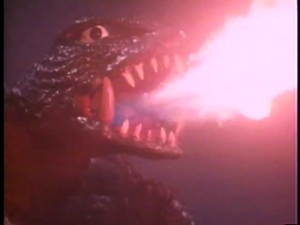
This is the exact midpoint of Gamera’s original (or “Showa Era”) film series. Not chronologically, or in any other terms material, but in terms of tone. This is the point where everyone at Gamera’s home studio, Daiei Film, gave up on the daikaiju genre as anything other than a cash cow. You can barely blame them. By 1967, the writing was on the wall and it said, “the only people stupid enough to abandon their TVs and visit some run-down, overcrowded, food-and-drink-stained movie theater are children.” Film as a whole suffered, but few suffered more than our favorite flying turtle, who would go on to star in some of the most notoriously bad films in daikaiju eiga as the seventies rose up to choke us all down with mediocrity, bad music, and even worse clothing.
Things didn’t have to be this way, but the makers of mid-60s Japanese cinema made the same mistake their American counterparts so often make and assumed (A) kids were the only ones watching their films and (B) kids were stupid. But there’s a difference between being stupid and not being able to articulate why you like something. My ten-year-old self knew Gamera was awesome on a molecular level but my current self still struggles to articulate why that is. Why do you think I’m writing these things in the first place? To finally pull back the curtain and figure out why, whenever someone goes, “Gamera? Really?” I always go “Fuck yeah, Gamera! He’s awesome.”
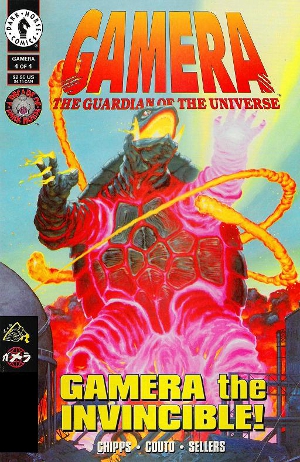
His movies, on the other hand, stopped being the “unbelievable, imaginatively cool” kind of “awesome” and started being the “incredibly cheap and incredibly crappy” kind of “awesome” right in the middle of this film. I can even show you where it happens: it’s the scene where Our Kenny – an incredibly annoying little snot named Eiichi (Naoyuki Abe) – takes a joyride on Gamera’s back.
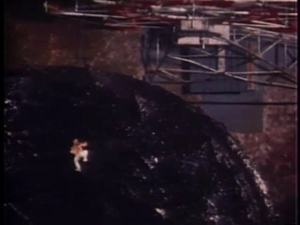
This is the point of no return; the point where the Gamera films become unabashed children’s fare. By the end of this film the Devil’s Envoy, Gamera – that one-time sinker of ships, decimater of hydroelectric dams, and straight-up destroyer of Tokyo – will cement himself into the role of superhero. This by itself was not a bad decision, but it was a poorly thought-out one, dictated by market logic, rather than the desire to tell a story. Kids loved superheros, and while English-language television feared and ridiculed the subgenre throughout the 50s and the 60s, Japanese TV embraced it with both arms and treasured it like a constant friend. Costumed avengers spent those post-war decades defended Japan (and by extension, the world) from all manner of giant monsters, asteroids and alien invasions. The kids (and plenty of adults, but never mind that – SF was strictly for the kiddies) loved it. And since kids were the only ones still going to movies, movie studios were bound to give them what they thought kids wanted. All they/we really wanted was a good Gamera movie. Instead, they gave us this. What’s that the Merovingian said to Hallie Berry’s Catwoman? “This is not even close to what I wanted.” Then again, I think Daiei misunderstood its target audience from the start.
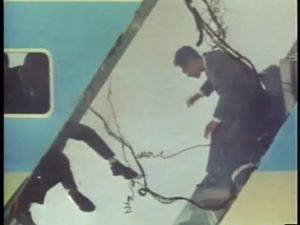
Indeed, I’ve always seen the original Kenny from the original Gamera movie as a cynical, mean-spirited, and actually quite-spot-on parody of the then-average daikajiu movie-goer: a naive, OCD little shit who spent the whole film almost getting people killed (and getting away with it) because he loved the monster more than his fellow human beings. Oh sure, he felt sad when Gamera torched Tokyo…but that only made him worse. Less realistic. Less identifiable to the kids in the audience, be we ten or thirty, who glory in giant monster rampages. Hate to break it to you but…if a giant monster waded up the Columbia River and into my town, I’d mouth all the usual pieties about “Oh, this horrible tragedy was so horrible with its horrifying horror…and shit.” But in my heart of hearts I know I’d glory in every single moment of it, from the monster’s First Sighting to its Initial Landfall to its eventual defeat by Super Science.
Unfortunately, the adults making these movies didn’t have quite our destructive urges. In some respects they played it safe, even by modern kid-movie standards. On the other hand, Gamera’s are some of the goriest daikaiju movies ever made, a proud tradition they carried on well into the 21st century. I wouldn’t have it any other way, as the ambient levels of gore are about the only thing I can still enjoy with that old “childish” enthusiasm, but the contrast only gets more intense (i.e., “funnier”) as things go on.
First, though, we have to suffer through Gamera vs. Gaos (or Gamera vs. Gyaos; or Giant Monster Midair Battle: Gamera vs. Gaos; or Return of the Giant Monsters), the bland, middle-of the-road Gamera movie no one would remember if it didn’t feature his most famous opponent. I’ve never liked Gaos, since he’s basically a Rodan rip-off, though the filmmakers tried to cover that by giving him a supersonic beam weapon and yellow gas that shoots out from jets in his arm pits. (No, really.) He’s also much smaller than Rodan, allowing him to interact with (i.e. “eat”) badly bluescreened humans on a more individual basis than your average Toho monster. So there’s that.

The plot is even more of a flagrant excuse to set-up monster fights than usual. A stereotypical development corporation run by your stereotypical Evil Capitalist is trying to link up two sections of highway. This will inevitably pave over a stereotypical rural community that seeks to stop the road crew and/or sell out to them for the highest possible price. Between all this, we have a Working Class Hero: foreman Shiro Tsutsumi (Kojiro Hongo – Keisuke from Gamera vs. Barugon), doing his best to do right by his crew and the slack-jawed yokels standing in the way of Progress.
Which comes to a grinding halt once a series of earthquakes wakes Mt. Fuji…and Gaos. Here’s your big misstep, right there: Gaos is not awakened by the road crew’s activities. Not in the same way those miners “woke up” Rodan, or that modern Progress has woken monsters the world over. Sure, the superstitious locals blame Gaos on the road crew, but what do you expect? They must’ve watched Rodan in its first run. Might’ve even seen Varan the Unbelievable. Hell, by this point, they could’ve watched the English version of Varan– which is a completely different movie – in a theater, re-imported and subtitled back into Japanese.
You might laugh, but that actually happened to Godzilla’s first adventure. You can thank Raymond Burr for the fact nearly every daikaiju film since features some kind of Reporter. Even this one. Eiichi – who is both Our Kenny and the grandson of the village headman – finds the poor Reporter wandering the woods and recommends the two explore a glowing cave they both stumbled across. As anyone with a functioning brain could’ve guessed, this is Gaos’ cave, and exploring it is a Capital B, Bad Idea. Eiichi flees this knowledge, but Our Reporter dies when Gaos (through the magic of sloppy editing) picks him up and tosses him back like a honey roasted peanut.

However, by menacing Our Kenny, Gaos signs his own death warrant. Gamera’s fights in this film take up at least as much screen time as the human fist fights took up in Gamera vs. Barugon. Too bad I’d actively prefer Gaos chow down on little Eiichi and end his high-pitched squealing. When Keisuke and Onodera fought, I cared about the outcome because I cared about the characters and understood what they were fighting for, and why. Here I’m wondering which piece of equipment Eiichi’s keening bleats will blow out first, my speakers or my eardrums. Gaos does manage to slice a bloody gash in Gamera’s arm, which is cool, but metaphorically speaking, a jet of fire of is still the coolest breath weapon around. The outcome of this fight (and every one to follow) wouldn’t be in doubt even if a child weren’t present.
With Gaos driven back underground, Gamera flies Eiichi to safety by setting the little shit down (gently) on his back. Now do me a favor: take your left hand, reach up, then back around, and casually scratch your left shoulder. Did you notice how much arm that took? The human arm is a highly developed and remarkably efficient thing. Gamera’s arms are not.
But considering what follows, that’s a minor nitpick, easily ignored in the ocean of nits swarming over this film like a Legion infestation. Gamera lands right outside of town without disturbing a single structure and Shiro just happens to be on hand to pluck Eiichi off Gamera’s back. In the original English dub – created by AIP-TV in the 60s – he even requests Gamera scooch closer to the too-convenient Farris wheel he’s climbed…and Gamera obeys. Bloody hell – we wasted a whole Z Plan rocket on this giant puppy dog? We could’ve been on Mars by now!

After this point, everyone abandons their narratives and starts standing around a conference table and speculating about how to stop the monster. When Keisuke and Karen did that in the last movie, at least they had some actual expertise offer. Well…Karen did, and Keisuke was crushing on her hard…which was entierly understandable. Here, Eiichi’s ushered right into the JDSF command and control room for a casual chat because…yeah. Shiro, Eiichi’s grandfather, and Eiichi’s big sister Sumiko (Reiko Kasahara) all stand around waiting for their cues, obvious chaperons to to the real star of the show.
You’d think Shiro would use this golden opportunity to get in good with Sumiko…or Old Man Kanemaru, for that matter. “Hey, asshole: I pulled your grandson off a giant, fire breathing turtle’s back. How about you call off your clodhopping minions, huh? What more do I gotta do to prove not everybody on the road company’s evil? Not go after your hot granddaughter? Because I can apparently do that, too.” Then again, signs of the dreaded Sex Drive must be kept out of children’s entertainment at all cost…right? Now, scenes of mass slaughter are just fine, so long as they’re created with bad bluescreen shots.
Actually, I like Gaos’ mid-movie attack on Nagoya, complete with the famous train sequence. (Visually gut-checked twenty-nine years later in the series reboot, Gamera: Guardian of the Universe). The late 60s seemed to be the right time for filmmakers to finally show giant monsters eating people. Oh, it’s nothing to get excited about as an image (once again, thanks to bad editing), but as a concept it blows my mind every time I think about it. It would take another four years for Godzilla’s enemies to gain similar powers. At this point, Godzilla himself hasn’t killed anyone since 1954 and he won’t kill anything smaller than a robot doppelganger until 1985. Gamera, on the other hand, will fuck a bird up faster than me at a community barbeque. Just get him close enough to sink his teeth in and he’ll come back with a foot.
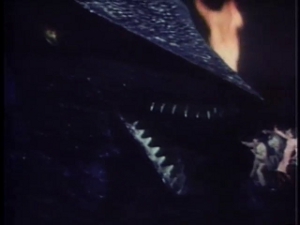
Back at HQ, observing that foot makes one of those lightbulbs go off over our Scientist, Dr. Aoki (Yoshiro Kitahara)’s head: Gaos is nocturnal. More than that – like any vampire worth their fangs, Gaos will melt when exposed to full sunlight. But making a great big ultraviolet light-spouting gun would be too impractical, and Gaos might get hungry in the interim. No, much better to construct a giant birdbath, fill it with fake blood, and spin it around until Gaos is so dizzy he won’t be able to fly back to his cave before dawn’s early light fries him like a two hundred foot strip of bacon. I still don’t know what’s sillier: the plan itself…or the fact that it almost works. The contrast between all those uniformed actors seriously discussing “Operation Whirleybird” as the comped-in Gaos spins right round, right round, outside their HQ windows, will never cease being hilarious. And it would’ve worked, too, if not for that blasted genre formula, keeping Gaos alive for the climactic monster fight.
And what an ill-paced fight it is, hampered by the reduced budget that transforms Gaos into a stiff, obvious rod-puppet whenever he takes flight. But there’s a remarkable amount of creativity on display here. Moreso, at least, than you’d find in contemporaneous Godzilla fights. Director Noriaki Yuasa obviously had some vision in him. You can see it in the opening shots: a roaring Gamera, climbing the rumbling slopes of Mt. Fuji as white titles rise into the foreground. It’s everything I love about daikiju movies in an image. Too bad it’s the best image in the movie…and comes about thirty seconds in. The human scenes of this movie are universally tension-free, with only the occasional hint of a creative camera angle to keep me awake. Similarly, special effects directors Kazufumi Fujii and Yuzo Kaneko come up with some interesting ideas, I just wish they’d had the money and/or time to execute them.
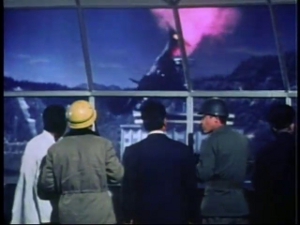
I dream of what could’ve been. This is the same writer, director, special effects directors, and stars that brought us Gamera vs. Barugon. I’d like to think screenwriter Nisan Takahashi penned a heartfelt and balanced examination of how rapid post-war urbanization and a widening generation gap vexed the collective soul of mid-60s Japan, similar to how vs. Barugon was all about the Self-Destructive Power of Greed. Then one or more of the Daiei higher-ups must’ve looked at it and said, “What the fuck do you think you’re doing here? Kids don’t give a shit about stories. They just want to see themselves represented on screen and they want to see monsters fight. That’s it.” So the movie got its Kenny (remember, vs. Barugon was the only Kenny-free Gamera film of this era) and all the “boring” character resolution stuff gets shoved into the last two minutes as an afterthought.
On balance, Gamera vs. Gaos is the middle-of-the-road Gamera movie, neither as good nor as outrageously bad as the films to either side of it. It’s necessary step for Gamera fans and series completists, but the curious non-fan is advised to either choose something else first, or make this your last stop on the Showa Gamera express line. After this, one should batten down one’s hatches and officially abandon all hope. For Gamera, and us, things are going to get a lot worse in a big hurry.
![]()
![]()
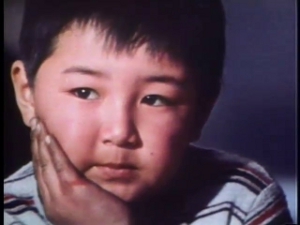

When I was a kid, Gyaos freaked me out. He ate people. Most of the Japanese monsters just stomped on stuff. Stomping on stuff seemed cool. I wanted to stomp on stuff. Eating people is just bad manners.
And unless you’re packing an army of tooth picks, it can be murder on your gums.
I know exactly what you mean, though. Rare is the kaiju that even notices people, never mind eating them outright. I will say, with complete honesty, that Gyaos is the second-best thing in the movie…after Gamera, of course.